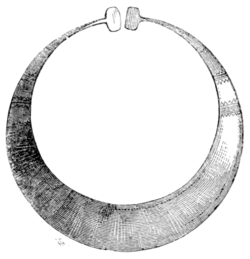probably the continuation of the iron wire on which the vertebrated beads are strung, must have been attached to the Perdeswell torc. That the British Celts were accustomed to wear similar decorations is evident from the testimony of Herodian, that the Britons wore the teeth of the seal or walrus strung as beaded torcs.
Gorget. This is a peculiarly Celtic ornament, and is almost limited to Ireland, where they are frequently found, and some have occasionally been discovered in Cornwall. It is always of gold, and consists of a thin lamina of metal, terminating at the ends in two round plates. Several notions about the adaptation of this object, more fanciful than correct, have been advanced. It has been supposed that it was worn as the Roman ladies wore the sphendone[1], on the top of the head, with the circular ends behind the ears; or that the ends may have been tied round the neck, so as to use them as a gorget. One with the ends not terminating in circles has been supposed to be the ornament of the Hibernian Druids, representing the moon in the first quarter, and hence called by Vallancey the cead raire[2]. Another, rather more massive, with the cup-shaped terminations visible on several Celtic decorations, has been called by the same authority[3] the iodhan morain, or collar of the celebrated judge of that name, which closed round the throat when the wearer gave wrong judgment, a virtue which would rather belong to a solid torques.
From its greater delicacy and comparative lightness, the gorget appears to have been an article of female attire, rather than an ornament worn by Druids. They all bear marks of having been hammered, and their open shape and circular termination is evidently suggested by the bulbous torques or armilla, which would, if hammered out, produce the gorget. As the armilla and torques were worn with the bulbous ends down, and as the

